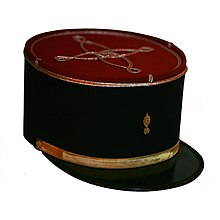Kepi

Kepi – czapka o kształcie ściętego stożka lub walca, wyposażona w daszek. Wprowadzona w I połowie XIX w. w armii francuskiej (gdzie używana jest do dziś)[1]. Z czasem zdobyła popularność również w innych państwach.
Amerykańskie wojskowe kepi z okresu wojny secesyjnej
Niemieckie kepi organizacji SA z okresu III Rzeszy
Przypisy
- ↑ kepi, [w:] Encyklopedia PWN [online] [dostęp 2021-07-28].
Media użyte na tej stronie
Autor: Uncredited photographer/USHMM, Licencja: CC BY-SA 4.0
Sturmabteilung Schaftmütze, SA Ostland-Westfalen M1933 kepi with eagle badge; SA - Dienstmütze (service cap), uniform cap for non-commissioned officers/enlisted men; wearing style 1936 - 1945; SA Group Ostland - Tannenberg; die stamped, silver colored, pronged metal badge of a right facing eagle with outspread wings, the talons grasping an oak leaf wreath enclosing a swastika; adjustable, dark brown leather chinstrap:
M1933 uniform kepi with maroon facing of the type issued to enlisted men and non-commissioned officers in the Sturmabteilung (SA), the paramilitary wing of the Nazi Party in the Ostland and Westfalen districts of Germany, between 1933 and 1937. The flat topped cap has a first pattern political Reichsadler badge; the second pattern was released in January 1934, but not required of SA members until June 28, 1937. The manufacture of official equipment was monitored by the Reichszeugmeisterei der NSDAP [National Equipment Quartermaster of the Nazi Party.] After the Nazi regime came to power in 1933, a colored band matching piping and gorgets was added to indicate the SA Gruppe or district from which the unit was drawn. In January 1934, a second pattern eagle was created, but worn primarily by political party leaders until June 28, 1937, when new orders requiring its use by SA members were issued. See also Uniforms and insignia of the Sturmabteilung.
Object in the collections of the United States Holocaust Memorial Museum (USHMM) in Washington, D.C. No restrictions on access or use.
Czapka polowa typu kepi w kamuflażu wz. 93.






